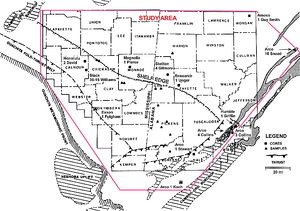Black Warrior basin
The Black Warrior basin of Mississippi and Alabama is a potentially large oil and gas province with numerous possible reservoir units. Oil and gas have been, or presently are, produced from the Cambro-Ordovician, Ordovician, Mississippian, and Pennsylvanian in the Black Warrior basin.[1]

The Black Warrior Basin is a triangular tectonic basin bounded on the north by the Ozark uplift–Pascola arch–Nashville dome trend, on the southeast by the Appalachian fold belt, and on the southwest by the buried Ouachita front–Neshoba uplift and to the west the Reelfoot rift (Figure 1). Mesozoic and Tertiary strata overlie the southern part of the basin. Upper Pennsylvanian, Mississippian, Devonian, Silurian, and Ordovician strata subcrop beneath the Mesozoic cover along much of the northern rim of the basin. In the Appalachian fold belt and Nashville dome to the east and northeast respectively, these units also outcrop.[2]
This article is a stub. You can help AAPG Wiki by expanding it.
References
- ↑ Boland, L. F., E. D. Minihan, and W. A. Thomas, 1971, Black Warrior Basin: AAPG Bulletin, v. 55, no. 9, p. 1692.
- ↑ 2.0 2.1 Fritz, R. D., P. Medlock, M. Kuykendal, and J. L. Wilson, 2012, Knox Group in the Black Warrior Basin in The Great American Carbonate Bank: The Geology and Economic Resources of the Cambrian-Ordovician Sauk Megasequence of Laurentia: AAPG Memoir 98, p. 301-344.